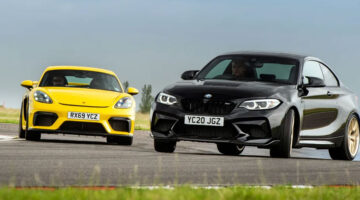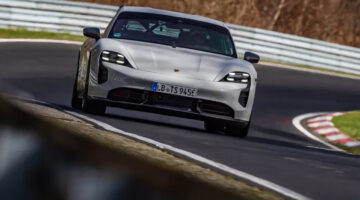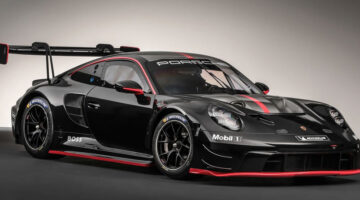With the go-ahead given, it was time to start the arduous process of building a race team from scratch. A vastly developed infrastructure, thanks largely to the success of both the Cayenne and the Panamera – two family-orientated models that rid Porsche of its ‘niche sportscar’ label – aided in this endeavour, and a 230-strong team (100 of which were engineers) and race headquarters at Weissach were set up in no time.
“We started putting the team together in 2011, but the moment when we said, ‘okay, let’s do this’ was in early 2012, and the pace really picked up after that,” Hartmut continues. “We really didn’t have a lot of time to put everything together, but I think what made it possible was that by that point, we had a small core group already doing pre-development – you remember I mentioned the GT3 R Hybrid before – bouncing ideas around simply because the way we thought about going racing had changed. So, when the decision was made, it really was like flipping a switch. We had to hire people of course, get them together, and define processes, so in that respect it took a lot of work. But I think it has been quite successfully done.”
First order of business was Porsche’s new prototype contender, GT cars no longer eligible for overall victory (and already vastly out-dated when Porsche took its final Le Mans victory in 1998). In-keeping with new fuel-friendly technical regulations, the 919’s hybrid system combines the 2.0-litre V4 with an energy retrieval system and electric motor package, power from which is transferred across both axles. Whilst 500hp from the V4 powers the rear wheels via a seven-speed racing transmission, energy recovered from the exhaust gases under braking is converted to electricity and stored in the on-board lithium-ion batteries (a principle similar to F1’s KERS system). Up to 185kW/250hp of electrical power can subsequently be sent to the front wheels, the almost instant torque from this re-generated energy essentially making the 870kg 919 all-wheel drive at select intervals around the track, improving overall pace and laptimes as a result.

It’s all phenomenally complicated, but such is the importance of every tenth-of-a-second given the ever-decreasing performance gaps in the WEC. And with no crossover between the new 919 and Audi’s established R18 e-tron – officially at least – Porsche was on it own. Unsurprisingly, development of the company’s 918 Spyder hybrid proved hugely significant.
“The 918 Spyder was important, specifically for our sportscar customers. When we look at what our sportcar customers want to buy, they may not look at what the fuel prices are: they buy these cars for their entertainment. And when everybody starts talking about reduction of fuel consumption and how to create performance in a car, you get scared. By showing the concept of the 918 Spyder and making it reality, we have created an interesting future where people can say that Porsche understands and can produce entertaining sportcars in the future with very low fuel consumption.
“Consider how the hybrid technology within our company has developed: four years ago at the Geneva Auto Show we presented the 918 Spyder as a show car, the 911 GT Hybrid as a racecar, and the Cayenne hybrid. Now four years later, these have all become reality. We have gone to the next step of hybrid technology, and for the size of our company, that is a huge achievement.”

One need only look at the driver line-up to understand Porsche’s focus on ‘achievements’. Of the six drivers across its LMP1 line-up, two are former outright Le Mans winners (Timo Bernhard and Romain Dumas), three are former category winners (Bernhard, Dumas and Marc Lieb), and combined the line-up boasts a frankly staggering 37 starts at Le Mans. Then there’s the elephant in the media room, Mark Webber. With 215 Grand Prix starts and nine victories to his name across 11 years, few could deny his talents behind the wheel. But before this year’s Silverstone 6 Hours, it had been 15 years since Webber’s last start in an endurance race, and his previous Le Mans efforts – though spectacular – were ultimately fruitless. Why then did the likeable Aussie prove such a crucial addition to the line-up?
“He has some experience with Le Mans that goes back as far as our last race here,” Hartmut explains (there goes the mobile again). “He’s also a typical example of how to meld different experience and know-how together. In Formula 1 today, it is motorsport at a very high and sophisticated level, so he is used to the media attention. Plus he already has experience with hybrid technology, so we believe he fits well with our brand and into our team.
“But it’s not just about Mark. All our drivers have to be quick and have to fit with our brand, but they all have different strengths and weaknesses, so at the end of the day you try to form a team that is as strong as possible. In endurance racing you don’t necessarily need the best or the strongest individuals because they’re not fighting against each other. You have to get people who fit well together, and that as a group are stronger than they would be as individuals.”

At this point, a roar from the commentary being pumped through the hospitality area’s speaker system grabs us both. All eyes are now firmly on the TV screens. An LMP2 car is off in the gravel and rain has been rumoured. Hartmut, all too aware that a sudden and ferocious downpour saw both an Audi and Toyota tangle and pile into the Armco earlier in the race, is focused firmly on the race, our conversation – understandably – now forgotten.
Ultimately Porsche’s return to Le Mans was not the fairy-tale ending many hoped it would be, despite the #20 car of Webber, Brendon Hartley and Neel Jani spending several hours heading the field. Both 919 Hybrids are eventually struck down with engine issues as the race enters its final stages, Audi producing a storming drive from behind to take its 14th win at the event in 16 years. There is disappointment of course in the Porsche garage, but at the same time satisfaction: for the 919 Hybrid to run almost three-times longer than it had hitherto managed – and competitively so – in only its third official race start marks an enormous statement of intent for Porsche.
The ‘17th win’ may not have emerged in 2014, but there’s no doubt the Weissach crew will not be satisfied until it does. It’s a result after all that’s now 16 years in the making. As we know, a lot can change in that time. Audi may want to remember that.
– FULL GALLERY OF SHOTS AVAILABLE HERE – CLICK – Shots courtesy of Eric Fabre



